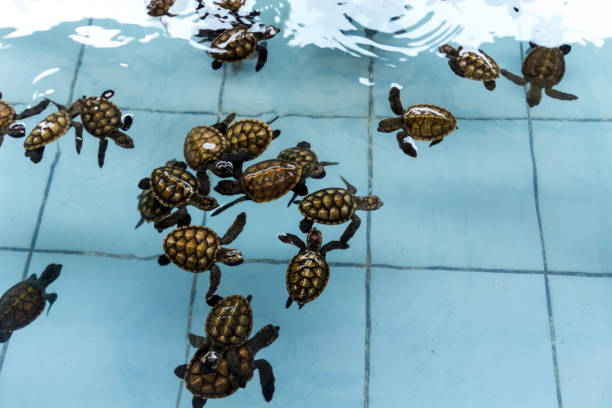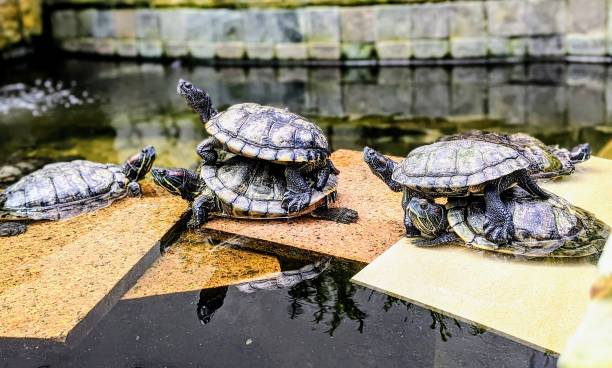In the animal kingdom, the collective names given to groups of creatures are often as fascinating and diverse as the animals themselves. From a murder of crows to a pod of dolphins, these terms add a layer of richness to our understanding and appreciation of wildlife. Turtles, with their ancient lineage and global presence, are no exception. Yet, many of us pause and ponder: what is the proper term for a group of these shelled reptiles?
In this comprehensive exploration titled “What Are A Group Of Turtles Called,” we dive into the world of chelonian collectives to uncover the terminology that binds them together. As we navigate through the etymology and origins of these linguistic gems, we also shed light on the behaviors and habitats that have influenced such terms.
Our expertise on this topic is built on a foundation of zoological knowledge and a passion for the cultural and historical contexts that have shaped the way we categorize the natural world. We don’t merely present you with a name; we offer a panoramic view of the world in which these groups thrive, and how the terms came to be, which adds depth to the monikers we use today.
The value of this content goes beyond trivial knowledge; it provides insight into the fascinating social structures of turtles and illuminates the human penchant for naming. We invite you to indulge your curiosity and join us on this linguistic and ecological journey to discover the collective nouns that capture the essence of these remarkable reptiles.
So, whether you’re a wildlife enthusiast, a language lover, or simply seeking the answer to this intriguing question, our article promises to enrich your understanding and leave you with a newfound appreciation for these venerable creatures. Let’s unravel the mystery, shall we?
Contents
The Most Common Turtle Collective Noun: Bale
The word bale is the most widely used collective noun when talking about a group of turtles. You’ve probably heard phrases like “a bale of turtles” before. Bale can refer to a group of turtles of any size, from just a few up to large gatherings.
Now you might be wondering – is bale an officially recognized scientific term or more of a casual phrase? The answer is that it’s an informal, colloquial word. There is no scientific taxonomic group called a “bale.” Bale likely arose as a way for people to easily describe turtle groupings they encountered.
While bale is common, it’s good to remember that it has no standardized scientific meaning. It’s simply a convenient word we use to talk about an assemblage of our shelled reptile friends.
Other Casual Terms for Turtle Groupings
In addition to bale, there are a few other informal or colloquial terms sometimes used to describe groups of turtles:
- Dole: A dole can refer specifically to a grouping of sea turtles, rather than land-dwelling turtles and tortoises. When large numbers of sea turtles migrate through the oceans, we may refer to them as a dole.
- Nest: For female turtles gathered together in an egg-laying area or hatchery, the term nest is occasionally used. This refers to turtles assembling at a nesting site, rather than generalized groupings.
- Turn: Turn is an old regional term used in some areas to mean a group of turtles. It likely arose from the saying “a turn of turtles” before being shortened.
As you can see, apart from bale, we don’t have many set collective nouns for turtles. Regional dialects may use specific phrases, like turn, but these aren’t widely adopted. Most turtle groupings are simply referred to informally as a bale or a gathering.
Regional Variations in Turtle Collective Nouns
Just as local accents and slang words vary regionally, some turtle collective nouns are more commonly used in certain areas.
For example, in the Florida and Gulf Coast regions where sea turtles are more prevalent, flotilla is sometimes used. This conjures images of turtles swimming together near the ocean surface.
Meanwhile, sleuth is a term you may hear in areas like the American Southwest where land-based desert tortoises live. Sleuth evokes the plodding, methodical movements of tortoises traveling together.
Of course, bale and other informal phrases like herd and flock work for all turtle species and regions. But it’s fun to learn some local variations.
Taxonomy – What Scientific Order Do Turtles Belong To?

Let’s get a little scientific for a moment. Taxonomically, turtles belong to the order Testudines. This order contains all turtles, tortoises, and terrapins living today.
Testudines is further divided into two suborders based on anatomy:
- Cryptodira – Turtles that can retract their heads back into their shells, like pond and sea turtles.
- Pleurodira – Turtles whose necks bend sideways into their shells rather than retracting directly, like side-necked turtles.
There are around 356 modern turtle species discovered so far, all falling under Testudines. Of course, turtles themselves likely don’t know what order they belong to – but this taxonomy helps us organize and understand the relationships between the many types of shelled reptiles.
Habitat Differences Between Turtles and Tortoises
While we lump turtles, tortoises, and terrapins together colloquially, there are some key habitat differences.
Turtles spend most of their time swimming and living in or near water. They have webbed feet for paddling and hydrodynamic shells. Examples are pond turtles and sea turtles.
Tortoises, on the other hand, live exclusively on land. They have stumpy feet adapted for walking, along with heavier, dome-shaped shells. Desert tortoises and Galápagos tortoises are examples.
Terrapins are turtles that live in both water and land habitats, splitting their time between the two. They have traits suited to semi-aquatic living. Red-eared slider terrapins are common terrapins.
Of course, when it comes to collective nouns, we use the same terms for all shelled reptiles, regardless of their habitat differences. A bale can refer to land tortoises, aquatic turtles, or semi-aquatic terrapins alike.
Examples of Collective Nouns for Other Species
To give more perspective, let’s look at some collective nouns used for other animal groups:
- Pride – Lions
- Murder – Crows
- Troop – Chimpanzees
- Pod – Whales
- Gaggle – Geese
- Coalition – Cheetahs
- Army – Ants
- Swarm – Bees
- Float – Jellyfish
- Band – Gorillas
- College – Puffins
As we’ve learned, while turtles have some informal collective terms like bale, most animal groupings have more set, recognized names. But whether it’s a pride of lions or a bale of turtles, collective nouns make it easier to describe and discuss the creatures sharing our world.
The Origin and History of ‘Bale’ for Turtles

Since bale is the most ubiquitous term for a group of turtles, you may be wondering about its origin. Unfortunately, there doesn’t seem to be a definitive answer on where the word comes from when applied to turtles.
Some linguists speculate that it arose as a shortened version of “a bale or turn of turtles” – essentially merging two phrases into one. Bale may have then stuck over other collective options thanks to its simplicity.
There also appears to be no record of when bale first started being used to mean a turtle assemblage. It is likely an informal phrase that arose organically over time. While the specifics are lost to history, we can still appreciate the usefulness of having a handy word like bale to describe turtle groupings of all kinds.
In Summary
When it comes to collective nouns for turtles, there are a few common options:
- Bale – The most widely used term for any group of turtles or tortoises
- Dole – Typically used for large gatherings of sea turtles
- Nest – Female turtles congregating in a nesting area
- Turn – A regional phrase referring to a grouping of turtles
While bale has no scientific meaning, it remains a convenient colloquial term we can use when talking about our shelled friends. Turtles belong to the order Testudines, containing all types of turtles and tortoises. And while they may not have an officially accepted collective noun, talking about a bale of turtles certainly paints a delightful picture of these ancient mariners of pond, river, and sea.

Trayce served as a grassroots leader and activist in Texas as President of Dallas and Texas Eagle Forum.
Trayce is Mom Caucus Member, Texas Conservative Mamas, Texas Conservative Grassroots Coalition Leader, and Grassroots America Champion of Freedom Honoree.
She currently serves as the Eagle Forum National Issues Chair on Human Trafficking.
Trayce received a Bachelor’s Degree in Marketing from Texas A&M
Currently, she homeschools her youngest child age 13 and graduated her six oldest children, ages 31 to 19.







